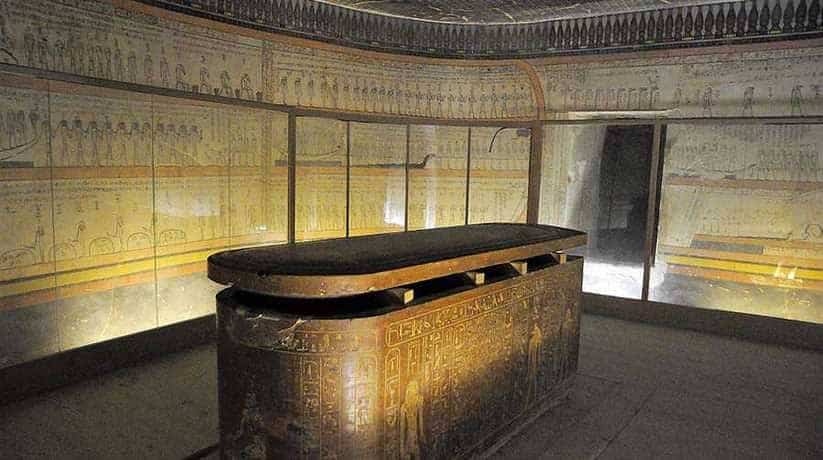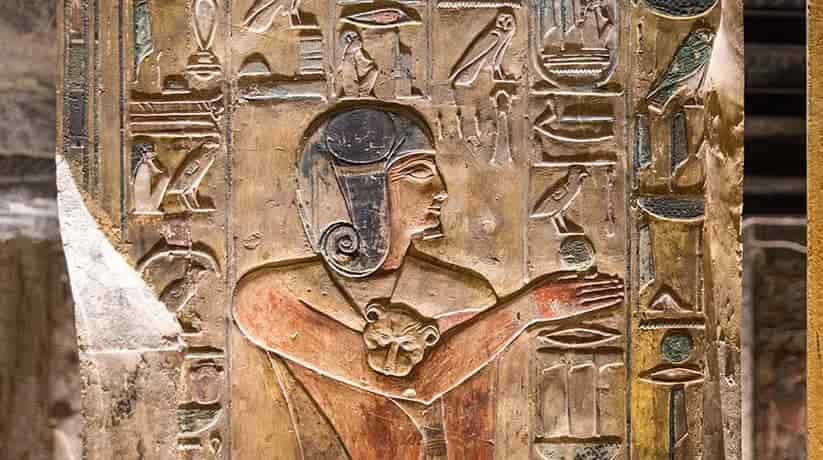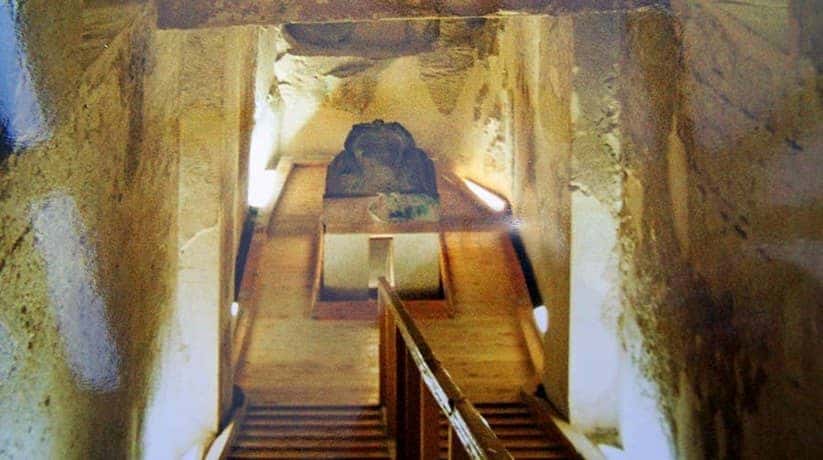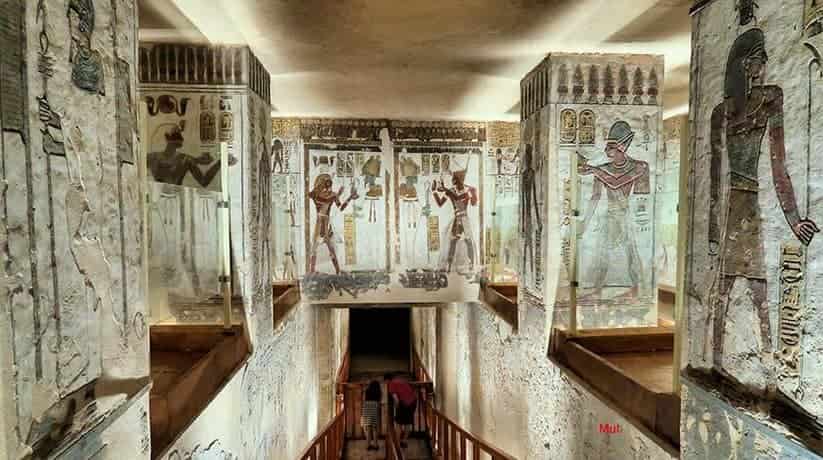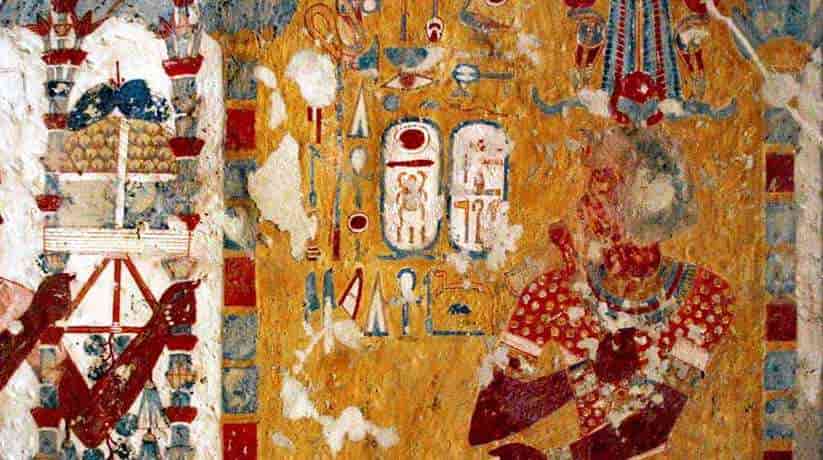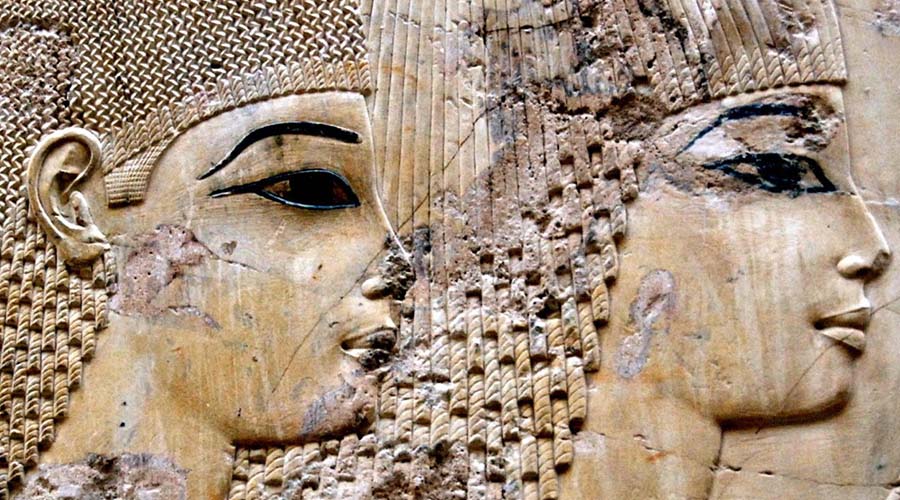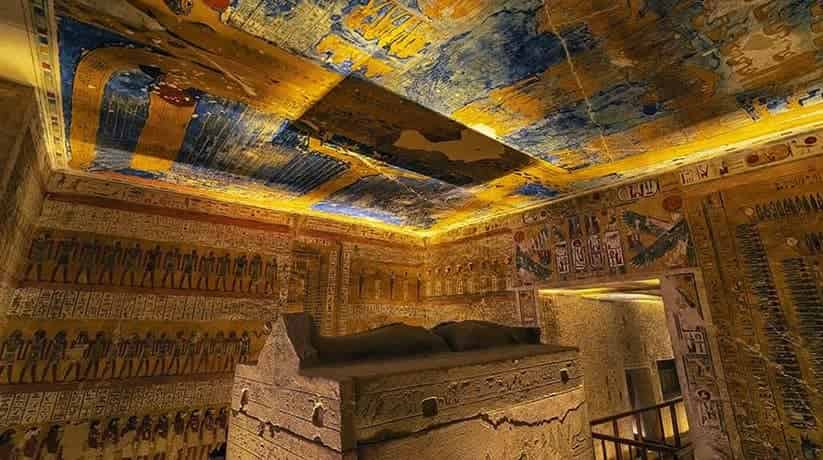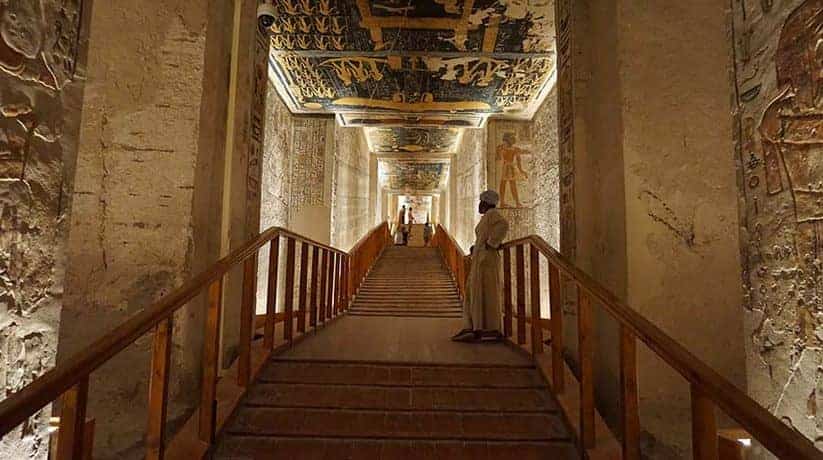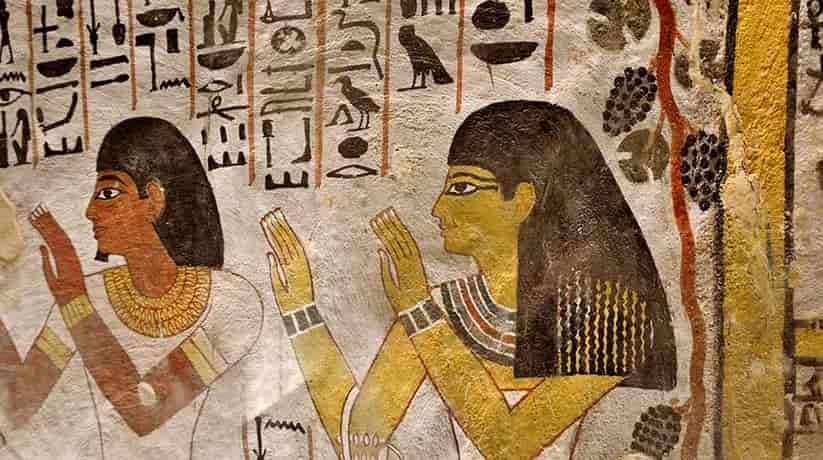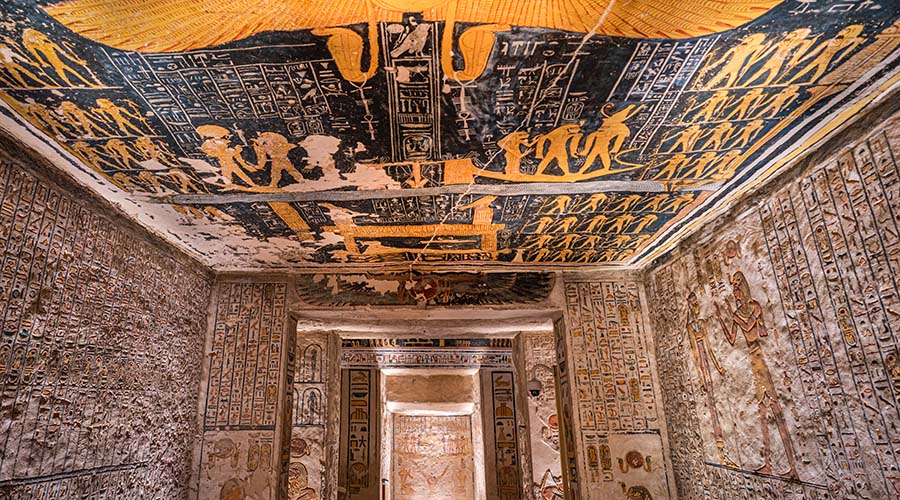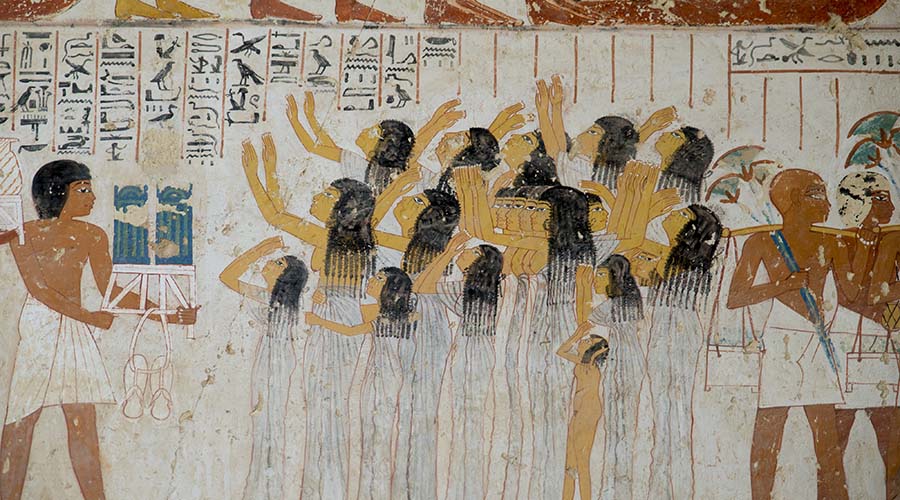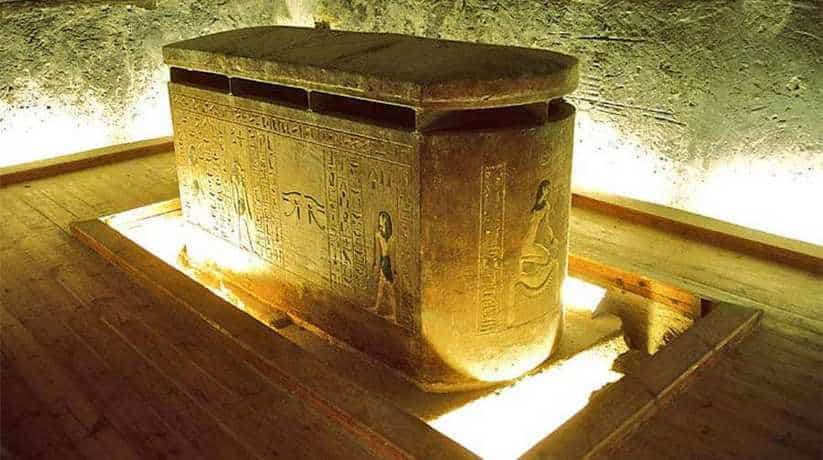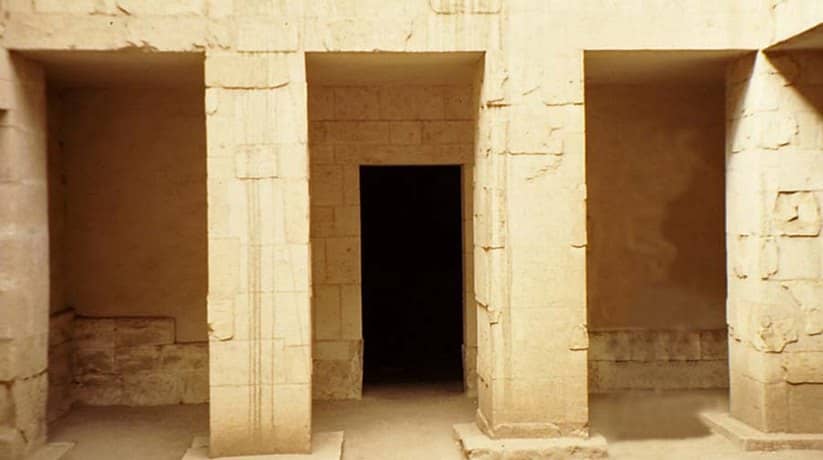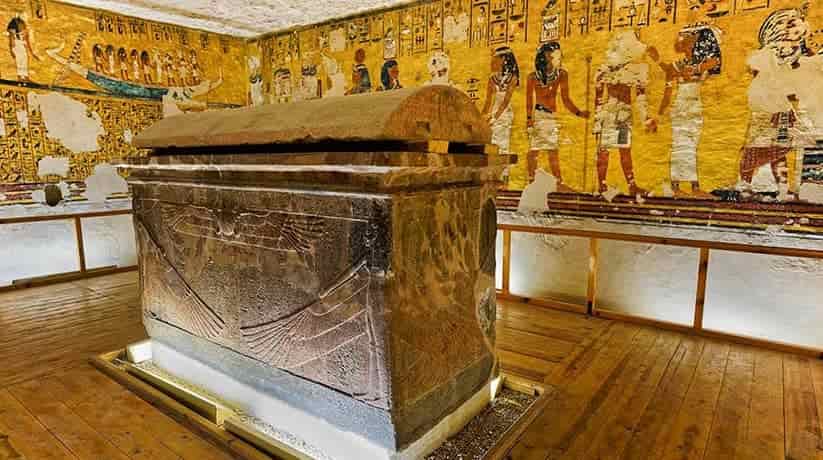Luxor tombs Egypt information, tours, prices, booking
Luxor tombs Egypt include Amenherkhepshef tomb. It referred by QV 55, located in Valley of Queens in West bank of Luxor. Amenherkhepshef is the son of Ramses III and the Great royal wife Titi. In fact, Titi listed in the tomb (QV 52) as God’s Wife and God’s Mother. Moreover, her tomb lies nearby and includes some of the same titles on its walls. The tombs of the sons of Ramses III indeed are the finest monuments in the Valley of the Queens.
Luxor tombs Egypt also include Amenhotep II tomb KV 35 which discovered in 1898 by Victor Loret. It is similar in plan to that of his predecessor Thutmose III. In fact, it is one of the most beautiful tombs in the Valley. The discovery was rather spectacular. It is because the tomb contained the burial of the king and his son Webensenu. Amenhotep II tomb is a large tomb with complex architecture.
Further details about Luxor tombs Egypt:
Luxor tombs also include Ankh hor tomb which is one of a series of large tombs in the Asasif area. The area located in the West Bank of Luxor. In fact, the tomb built at the end of the Third Intermediate Period. It built for high officials in the estates of the Gods Wives of Amun. The great importance of the Gods Wives during this time reflected in the size of the tombs. Moreover, these tombs of their chief administrators, that of Ankh-hor being no exception.
Luxor tombs Egypt also include Ay tomb WV 23 which belongs to King Ay, Tutankhamun’s successor. In fact, it found in the Western Valley. The Western Valley branches off at the entrance to the main Valley of the Kings. Moreover, only two completed king’s Tombs found here to date. The other being the tomb of Amenhotep III (WV 22). It recently undergoing re excavation and restoration. In fact, the burial place of Ay tomb Luxor discovered in 1816.
More details about the sites:
Luxor tombs also include Horemheb tomb which discovered by a young British Egyptology man named Edward Ayrton. It was in 1908. Horemheb was the successor of Ay, who in turn, had succeeded Tutankhamun as pharaoh of Egypt. He actually not related to the earlier kings of the 18th dynasty. Though he served in the courts of first Amenophis IV, and then Tutankhamun and finally Ay. Horemheb was a royal scribe and general of the armies at various times. He restored the old worship of Amun. Furthermore, he also reconstructed the provincial administration and military cadres.
Luxor tombs Egypt also include Inherkhau tomb TT 359. The tomb located in the necropolis of Deir el Medina on the West Bank at Luxor. In fact, the tomb indeed has rich and refined decorations. Moreover, the tomb represents some of the best artistic work of the 20th Dynasty. The tomb is the only tomb in this necropolis that we know which dates back to that dynasty. There are decorations in an upper chamber and the burial chamber. Furthermore, all painted on a yellow background.
Further details about Luxor tombs Egypt:
Luxor tombs also include Khaemhet tomb TT 57 which is a private tomb. In fact, it located on the West Bank at Luxor (ancient Thebes). Khaemhet (also known as Mahu) was the “Overseer of the Granaries of Upper and Lower Egypt”. Moreover, he also was a Royal Scribe. He married to his wife named Tiyi. Khaemhet tomb gives a lot of attention to another scribe by the name of Imhotep. We do not no much about the rest of his family. For example, children do not appear to pictured on the walls of Khaemhet tomb in Luxor.
Luxor tombs Egypt also include Khaemwaset tomb QV 44. The tomb located in the Valley of the Queens in the West Bank of Luxor. In fact, Khaemwaset is one of the sons of Ramses III. The tomb discovered in February 1903. It is with a many sarcophagi which pilled up in the entrance corridor. This was a clear sign that it used for common burial. In fact, Khaemwaset had among his most important roles, that of Priest of Ptah in Memphis.
More details about the sites:
Luxor tombs also include Kheruef tomb. It found in the area of Asasif, to the south of Deir el-Bahri in Luxor. Kheruef, also called Senaa, was Steward of the Great Royal Wife, Tiye. It was during the reign of Amenhotep III and Amenhotep IV. In fact, the tomb complex is large, as befits a man in his exalted position. Moreover, the tomb unfinished at the time of his death (he never buried in the tomb). Most of the inner rooms of the structure closed off. The tomb entered down a staircase and passage. The passage also leads to a large open court leading to several other later tombs.
Luxor tombs Egypt also include Khonsu tomb TT 31 which located in the west bank of Luxor. The tomb of Khonsu in Luxor has many lovely paintings. They depict the cult of the god Montu and Thutmose III. In fact, Khonsu (also called To) was a priest of the cult of Thutmose III. His title was “First Prophet of Menkheperre”, during the reign of Ramses II. Two offering stelae set up against the wall at either side of the entrance to Khonsu tomb.
Further details about the sites:
Luxor tombs also include Menna tomb which found in the upper enclosure at Sheikh Abd el-Qurna. In fact, the tomb well-known for its superb wall paintings of scenes of daily life. The scenes depicted in bright colors. The classical private tombs on the West Bank at Luxor referred to as T-shaped. It particularly those located on the slopes of Sheikh Abd el-Qurna. The tomb is in the area which known as the Tombs of the Nobles. The tomb has an entrance corridor or a courtyard.
Luxor tombs also include Merneptah tomb KV 8 which located in a small, lateral valley. It is on the right side of the main wadi in Luxor. In fact, Merneptah was a son of Ramses II and Queen Isis-Nofret. The tomb discovered by Howard Carter in 1903. Howard Carter was not as famous then. As he would not make his well known discovery of Tutankhamun tomb until 1922. Moreover, the tomb is near his father’s huge tomb (KV 7). When discovered, the tomb was full of debris and stood open since antiquity.
More details about Luxor tombs Egypt:
Luxor tombs also include Nakht tomb TT 52 which located in Sheikh Abd el-Qurna, part of the Theban Necropolis. The tomb is on the west bank of the Nile, opposite to Luxor. It is the burial place of the Ancient Egyptian official, Nakht. Nakht was a scribe, holding the title, “Astronomer of Amun” at the Karnak temple. It was during the 18th dynasty. In fact, his job was to study the location of stars, the sun and moon. It was schedule festivals and cult rituals for the temple.
Luxor tombs Egypt also include Pabasa tomb which located at Asasif in West bank of Luxor. It belongs to Pabasa who also called Pabes. In fact, the tomb is just outside the entrance to Hatshepsut’s Temple at Deir El Bahri. Moreover, Pabasa was the “Chief Steward of the God’s Wife Nitocris” (Neitiqert). It was during the reign of Saite king Psamtek I. Furthermore, Pabasa was like Ankh-hor, who held this important title after him. Furthermore, the tomb still has a large mud brick superstructure. It also has a steep flight of stairs.
Further details about the sites:
Luxor tombs also include Pashedu tomb TT 3. The tomb of Pashedu located in the necropolis of Deir El Medina on the West Bank at Luxor (ancient Thebes). Little known about this individual. He had the title, “Servant in the Place of Truth on the West of Thebes”. In fact, the tomb itself dated back to the early years of Ramses II. That is why the deceased began working while Seti I was King. Pashedu’s father, Menna, worked for Amun temple on the East bank. Pashedu was the first member of his family to work with the community at Deir El Medina.
Luxor tombs Egypt also include Queen Nefertari tomb QV 66 which discovered in the Queen’s Valley in 1904. In fact, Queen Nefertari tomb hewn out in the Valley of the Queens. Moreover, it called by the ancients “The Place of Beauty”. The tomb indeed is the most beautiful in the Valley of the Queens. It is on the whole worthy of her position in history. The tomb features decorative motifs on walls and ceilings which indeed are mythological. In fact, they concerned with life in the netherworld and meetings with gods.
More details:
Luxor tombs also include Queen Titi tomb QV 52 which located on the West Bank at Luxor (ancient Thebes). It is in the area which known as the Valley of the Queens. Queen Titi tomb is somewhat smaller in scale than many other royal tombs of the 20th Dynasty. It damaged by later reuse. Though we are not sure about the position which Titi held within the Ramesside royal court. We believe that Queen Titi maybe was a wife of Ramses III and maybe also was his daughter.
Luxor tombs Egypt also include Ramses III tomb KV 11 which is a complex system. It known since antiquity. In fact, the tomb explored during modern times by James Bruce in 1768. Later, William Browne gained access to the burial chamber in 1792. Belzoni removed the sarcophagus and lid, which are now in the Louvre Museum. In fact, he named it the “Tomb of the Harpists”. It is due to a bas relief representation of two blind harpists.
Further details:
Luxor tombs also include Ramses V tomb which situated just behind Tutankhamun tomb in the Valley of Kings. In fact, the tomb also has Ramses VI tomb. The decoration from the entrance as far as the well-room done for Ramses V. It not known for certain whether the pharaoh, who ruled for only four years, ever buried in the tomb. In fact, the tomb completed by his successor Ramses VI. His sarcophagus fragments found in the burial chamber.
Luxor tombs Egypt also include Ramses VII tomb KV 1. The tomb is open since antiquity, at least since Greek and Roman times. It mentioned in more recent times by Wilkinson, Lane and Hay. The tomb also mentioned in other 19th century travelers. Later still, Davis may have done some work in the tomb between 1905 and 1906. There is no information on its actual clearing earlier in the 20th century. The tomb seen some clearing activity by the Egyptian Antiquities department after 1952. Since 1984, Edwin Brock has worked the tomb, at first clearing the pit in the burial chamber floor.
More details:
Luxor tombs also include Ramose tomb which located in the village area of Sheikh Abd el-Qurna. In fact, Ramose was “Governor of the Town” (Thebes) and Vizier during the Dynasty XVIII transition. It was in the reigns of Amenhotep III and IV. The tomb indeed reflects his important position in the royal court and. Moreover, it represents the change in style towards “Amarna art”. In fact, it is uncertain whether the deceased ever buried in the tomb. Maybe he followed Akhenaten to his new capital Akhetaten. But no tomb has found for Ramose there.
Luxor tombs Egypt also include Ramses I tomb KV 16. It is one of the smallest tombs in the Valley of the Kings. The Valley of the Kings located in the West bank of Luxor. In fact, Ramses I is the founder of the great lineage of Ramessid rulers. Moreover, he was a soldier. He chosen by Horemheb. In fact, Horemheb also began his career as a soldier, to be his successor. Ramses I regarded as the first ruler of Egypt’s 19th Dynasty. But only ruled for less than two years. In fact, Ramses I tomb discovered on or before October 11, 1817 by Giovanni Battista Belzoni.
Further details:
Luxor tombs also include Ramses IV tomb KV 2 which situated in a large modern courtyard. The courtyard is near the entrance to the Valley of Kings in Luxor, Egypt. Coptic graffiti suggests that it reused as a Christian church or dwelling. It was during the 5th century AC. An ancient plan of Ramses IV drawn on papyrus is now in the Turin Egyptian Museum. In fact, the original plan was for a larger tomb which amended at the death of the king. The abbreviation means that there is no traditional pillared hall before the burial chamber.
Luxor tombs Egypt also include Rekhmire tomb which located on the south-eastern slope of the upper enclosure. It is at Sheikh ‘Abd el-Qurna, a little below the tomb of Sennefer (TT 96). Rekhmire was “Governor of the Town” (Thebes) and “Vizier”. It was during the reigns of Thutmose III and Amenhotep II of Dynasty XVIII. As the highest civil official of the land, Rekhmire built his tomb as a simple T shaped structure. It is in the traditional style, although on a larger scale. Moreover, the tomb has the unusual features of a long passage with a sloping ceiling. The passage does not contain a burial shaft.
More details about Luxor tombs:
Luxor tombs also include Roy tomb TT 255 which located in the West Bank of Luxor (ancient Thebes). The tomb is in the region which known as Dra’ Abu al-Naja, at the northern end of the Theban necropolis. Moreover, Roy tomb is on the hillside just before the road turns off towards the Valley of the Kings. It is one of two in this area that have recently opened to the public. In fact, Roy tomb is a small tomb with only a single chamber. The chamber includes a burial shaft which measures about 1.85 by 4 meters. It also preceded by an open courtyard.
Luxor tombs Egypt also include Sennedjem tomb TT 1. The tomb located in the necropolis of Deir el Medina on the West Bank at Luxor. It indeed was one of the great discoveries which found in tact by Italian archaeologists in 1886. Nothing had disturbed, as was not even the case with the tomb of Tutankhamun. In fact, all the decorations within Sennedjem tomb, painted on a background of yellow ocher. They are intact and indeed some of the most beautiful within the necropolis. In fact, Sennedjem had the title “Servant in the Place of Truth”.
Further details about Luxor tombs:
Luxor tombs also include Sennefer tomb TT96 which is famous for for its decorations. In addition, Sennefer well known as “The mayor of Thebes”. The tomb situated high on the southern hillside of Sheikh Abd El-Gurna. It is on the West Bank at Luxor (ancient Thebes). The is in an area which known as the Tomb of the Nobles. Moreover, it is close to several other tombs of the time of Amenhotep II. This also include the well known tomb of Rekhmire (TT 100). The tomb overlooks the Ramesseum and the alluvial plain of the Nile. It takes the classic “T” plan of the private tombs.
Luxor tombs Egypt also include Seti I tomb KV 17. In fact, it is the longest, deepest and most completely finished in the Valley of Kings. It is at more than 120 meters. Seti I tomb also represents the fullest development of offset, or jogged royal tombs in valley. The tomb discovered in October 1817 by the strongman of the early antiquarians. He was the Italian Giovanni Battista Belzoni. In fact, Seti I tomb still known as Belsoni’s tomb. The tomb discovered only a few days after the tomb of his father, Ramses I.
More details about Luxor tombs:
Luxor tombs also include Seti II tomb KV 15. The tomb known since antiquity and must have lied open during most of the classical period. It judged from the 59 Greek and Latin graffiti found on its walls. The tomb investigated by Pococke, along with others who followed after him. In fact, it was Howard Carter who cleared most of the tomb. Moreover, it was between 1903 and 1904. Though the ritual well never excavated. One may find the entrance to the tomb, rather than having steps cut below a retaining wall. It quarried into the base of an almost vertical cliff face.
Luxor tombs Egypt also include Shuroy tomb referred to tomb TT13. It is a small, T- shaped and two chambered structure on the West Bank at Luxor. In fact, the tomb belongs to Shuroy and his wife, Wernefer. Moreover, the tomb located at Dra Abu el-Naga. Shrouy was the Head of the Brazier Bearers in the Temple of Amun at Karnak sometime during the 19th Dynasty. It is while his wife was a singer of Amun. Furthermore, Shrouy tomb characterized by scenes drawn, sometimes only in red ink outlines.
Further details about Luxor tombs:
Luxor tombs also include Siptah tomb which found on the north face of a hill. The hill divides the southeast and southwest branches of the central wadi. It is within the Valley of the Kings on the West Bank at Luxor (ancient Thebes). In fact, It oriented north-south running straight for a distance of 114.04 meters into the hill. It also reaches a depth of about 13.12 meters. In fact, the name of Siptah means “Son of Ptah, Beloved of Ptah”. Moreover, King Siptah was the son of Seti II and Queen Tiaa.
Luxor tombs also include Tausert tomb KV 14 which known in fact as Tawosret and Setnakht tomb. It indeed is one of the most unusual tombs in the Valley of the Kings. Moreover, the tomb is also one of the largest tombs in the Valley of Kings. It encompasses two complete burial chambers. The tomb open and known since antiquity. Between 1983 and 1987, it studied in detail by Hartwig Altenmiller. The tomb built by Tausert, a queen and wife of Sethos II who later ruled Egypt as Pharaoh.
More details about Luxor tombs:
Luxor tombs also include Thutmose III tomb KV 34 which located in an almost inaccessible cleft. The cleft is in the southern end of Valley of the Kings. In fact, the entrance of the tomb reached by a steep climb up a modern staircase. The tomb discovered in 1898 by the workmen of Victor Loret. In fact, it is the earliest of the royal tombs which can visited at present. Moreover, the tomb built for the king in mid-Dynasty XVIII. There are two flights of steps and descending corridors.
Luxor tombs Egypt also include Thutmose IV tomb KV 43. It sited high in the southern cliff of the Valley of Kings. In fact, it discovered in 1903 by Howard Carter. The tomb stripped of valuable items in antiquity. Moreover, there were some funerary objects which found during excavation. The most interesting points of Thutmose IV tomb indeed are the construction and decoration. In fact, they show the development of style in tomb building during Dynasty XVIII. The tomb is like the earlier tombs.
Further details about Luxor tombs:
Luxor tombs also include Tutankhamun tomb KV 62 which located at the Valley of Kings in Luxor. The number of Tutankhamun tomb is KV 62. In fact, Tutankhamun was only the age of nine when he became king of Egypt. It was during the 18th dynasty of the New Kingdom 1332–1323 BC. The tomb discovered in 1922. It was by the archaeologist Howard Carter in the Valley of the Kings. His nearly intact tomb held a wealth of objects. Moreover, they give us unique insights into this period of ancient Egyptian history. Tutankhamun ruled after the Amarna age.
Luxor tombs Egypt also include Userhat tomb TT 51 which also called Neferhabef. It bore the title “First Prophet of the Royal Ka of Thutmose I”. It was during the reign of Seti I. His tomb is close to that of Khonsu in the village area of Sheikh Abd el-Qurna. In fact, it shows fine detailed paintings of the rituals about the mortuary cult of Thutmose I. The tomb also located in the West Bank of Luxor, Egypt. Moreover, the tomb has a courtyard containing a stela on the left hand side. It leads into a transverse hall.

